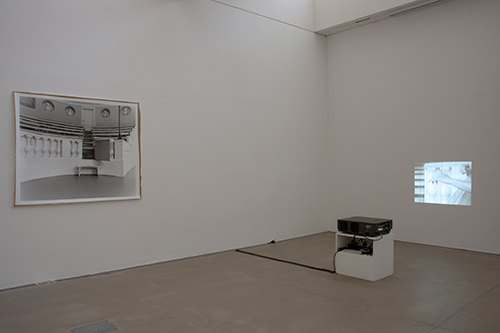
Mind Circles was an exhibition project that collaborated with the previously realised exhibition Human Silver Halo. The physical origin for both exhibitions is the Medical Museion in Copenhagen, housed in a building the Danish King had built for his surgeons in 1787. The exhibited artworks were derived through conceptual deliberations that embrace the intricate and handmade. Similarly, the choice of medium for this extended 'medical' project became analogue photography due to its use of silver, which has been connected with anti-disease properties since Hippocrates.
Mind Circles was a laboratory, where artworks were in flux during the exhibition. The lab’s ‘raw’ materials consisted of twelve large-scale (130cm x 180cm) analogue handmade photographs, a 16mm silent film, red ink, geometric objects and a couple of cross-disciplinary talks.
At the beginning there were twelve human-sized photographs pinned to the walls. Throughout the exhibition several photographs were made into objects. Individually, a photograph was removed from the wall, rolled up and soaked in water. The wet photograph was then shaped and left to dry over a geometric object; for example, a large sphere.
Two cross-disciplinary specialists visited the exhibition to further explore representations of knowledge. Maia Angelova, Professor of Mathematical Physics shared her specialist knowledge on symmetry and Dr Cristiana Cavina Pratesi, Research Fellow in Psychology talked about the brain. Both events were informal talks where the speakers had been requested to use objects instead of the ubiquitous digital images that their fields generally rely on. During the talks, inspired by Maia and Cristiana and seated next to them, the artist drew on one of the photographs that had been placed on a large table. The drawing was made directly onto the photographic surface with red ink, and it consisted of simple yet intricate circles that anybody could do. The delicate circles accumulated into abstract drawings that consciously responded to the talks on symmetry and perception, as well as the original photograph that hosted the marks. It was a conscious public exploration of how specialist scientific (difficult?) knowledge can ‘feed’ us in a multitude of ways – ways that are not necessarily connected with traditional logic and understanding.
The last component in Mind Circles was Concealed Ovation (part three) a black and white 16mm silent film. It shows a fixed close-up of a woman’s hands playing a harp within the Medical Museion’s now familiar auditorium (with thanks to musician Trine Opsahl). The harp-player’s hands, together with the mentioned ‘handmade’ pieces and traces, lend a voice to a process of labor – a process of knowledge – that is a key factor when examining a history of knowledge, if the intention is to represent both genders.